VIZUĀLO MĀKSLU PORTĀLS
|
|
|
Kur iegādāties? Iegādāties iepriekšējos Nr. Par mums
| Iznācis jauns žurnāls "No Order. Art in a Post-Fordist Society" NABA – the Nuova Accademia di Belle Arti di Milano and Archive Books (Berlin) are pleased to announce the publication of a new art magazine: No Order. Art in a Post-Fordist Society. This editorial research and investigative project focuses on the relationships between contemporary art systems and capitalism’s production methods. | ||||||||||
 | ||||||||||
| By means of an investigation into current creative industries – and their social, economic and semiotic assemblages – the magazine contributions (essays, articles, interviews and dialogues as well as artists’ projects) aim to deconstruct, analyse and intervene within the ambit of the methods and forms of cognitive capitalism. It will concentrate, in particular, on the phenomena of the ‘biennalisation,’ ‘financialization’ and ‘spectacularization’ of the political, beginning with the control and distribution of forms of artistic education, production and display on a global scale. No Order. Art in a Post Fordist Society is edited by Marco Scotini, published by Archive Books (Berlin), promoted and supported by NABA – Nuova Accademia di Belle Arti di Milano. The Editorial Board, is comprised of a series of transversal figures from various (including geographic) cultural environments, and includes Asef Bayat, Harun Farocki, Peter Friedl, Maurizio Lazzarato, Sylvère Lotringer, Achille Mbembe, Angela Melitopoulos, Christian Marazzi, Nelly Richard, Florian Schneider, Nomeda & Gediminas Urbonas and Françoise Vergès. Amongst the numerous contributors to the first issue of around 400 pages, appear: the curator Roger M. Burgel, Vasif Kortun, Charles Esche, Viktor Misiano, the sociologist Maurizio Lazzarato and the economist Christian Marazzi, the filmmakers Deimantas Narkevičius, Harun Farocki, Yervant Gianikian & Angela Ricci Lucchi, the Russian philosopher Alexei Penzin, the Chilean theorist Nelly Richard and the German art historian Astrit Schmidt-Burkhardt. There are artist’s projects by Stephen Willats, Erick Beltrán, Harun Farocki, Société Réaliste, Falke Pisano, the Argentinian collective Etcetéra, Rossella Biscotti, Luca Frei, Oliver Ressler and Vangelis Vlahos, amongst others, who contribute with essays, graphic designs or maps and cartographies. No Order is published annually in a bilingual version (English and Italian). Over and above the normal divisions and pre-established formats of periodical art magazines, this editorial project is structured into an assemblage of three sections: Time Zone/Play Time/Time Machine. The cartographies in Time Zone trace out emerging artistic ‘systems,’ geographies of governmental disparities, and different dynamics of cultural work. What is at stake here is the position that these local systems are adopting in the globalised system of contemporary art. This section focuses on the way the role of cultural industries is affecting various economic scenarios around the world. Drawing a map also means shifting attention towards the rules, dispositifs, and corporate identities that govern the conditions of creative work: institutions, commercial galleries, biennials, and communication. This means giving visibility to the changing relationships between these coordinates of identification. Time Zone is quite simply a rewriting of the opening section of art magazines – that of news and appointments. In this issue: Russia, the Czech Republic, Romania, Croatia and Turkey. Play Time corresponds instead to the central section of an art magazine, which is generally given over to monographic essays on particular artists. Categories like ‘author’ and ‘work’ are concepts that belong to a particular historic period – that of the modern age – but they are no longer able to analyse and portray the processes of contemporary production. The crisis of the Fordist production model has long since brought into play the constitutive relationships between authors, professionals, and walk-on and non-expert actors, paving the way for a new distribution of intellectual, creative, and political functions and roles that extend beyond their own individual disciplines. Deconstructing the hyper-visibility of some organisations and giving visibility to the invisible networks and processes that permeate the space of art, in a collective chain of Education/Market/Display, thus becomes the only possible form of action in today’s state of ‘work.’ The section Time Machine aims to completes the issue questioning the position of time at the heart of capitalism, but no longer in the ‘modern’ form, which based the production process on the contrast between use value and exchange value, and thus, by extension, on the dialectic between reality and representation. On the contrary, time – which is based on potential/actual relationships – is now the basis for the information economy. At a time when appearance has entirely replaced reality, the subject is always a ‘power,’ in as much as it is memory, on the point of manifesting itself. The last section of art magazines is given over to art reviews, and the category it deals with is always the time dimension of ‘after.’ The cover picture is taken from the demonstrations at the Milan Triennale in 1968. The underlying theme of the XIV International Exhibition of Modern Decorative and Industrial Arts and Modern Architecture was ‘Large Numbers.’ The XIV Triennale never opened. Since it was occupied by the students during the demonstrations, all the exhibit areas were destroyed. ‘Why not try to start again, precisely here in Milan? In that same space in which the great process of social transformation was interrupted?’ www.no-order.net | ||||||||||
| Atgriezties | ||||||||||
| ||||||||||








